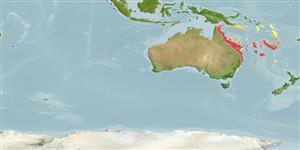Common names from other countries
>
Eupercaria/misc (Various families in series Eupercaria) >
Lutjanidae (Snappers) > Lutjaninae
Etymology: Lutjanus: Malay, ikan lutjan, name of a fish.
More on author: Castelnau.
Environment: milieu / climate zone / depth range / distribution range
Sinh thái học
Biển Cùng sống ở rạn san hô; Mức độ sâu ? - 20 m (Ref. 9710). Subtropical; 10°S - 37°S, 143°E - 170°E (Ref. 55)
Western Pacific: restricted to the east coast of Australia and New Caledonia. The main Australian distribution is off southern Queensland between Cape Moreton (about 27°S) and the Capricorn Group(23°S). This species has been usually referred to as Lutjanus amabilis by previous authors.
Length at first maturity / Bộ gần gũi / Khối lượng (Trọng lượng) / Age
Maturity: Lm 25.0, range 20 - 30 cm
Max length : 50.0 cm TL con đực/không giới tính; (Ref. 55); common length : 30.0 cm TL con đực/không giới tính; (Ref. 55); Tuổi cực đại được báo cáo: 40 các năm (Ref. 2290)
Các tia vây lưng cứng (tổng cộng) : 10; Các vây lưng mềm (tổng cộng) : 14; Tia cứng vây hậu môn: 3; Tia mềm vây hậu môn: 8. Snout somewhat pointed. Preopercular notch and knob moderately well developed. Scale rows on back rising obliquely above lateral line. Generally pale blue-gray to whitish with suffusion of yellow on upper back. A prominent golden brown stripe, slightly narrower than the eye, runs laterally from the rear edge of the of the opercle to the caudal peduncle.
Adults mainly inhabit coral reefs. Sometimes forming large aggregations around rocky outcrops during daylight hours. They disperse to feed at night (Ref. 9710). Usually marketed fresh.
Life cycle and mating behavior
Maturities | Sự tái sinh sản | Spawnings | Egg(s) | Fecundities | Ấu trùng
Allen, G.R., 1985. FAO Species Catalogue. Vol. 6. Snappers of the world. An annotated and illustrated catalogue of lutjanid species known to date. FAO Fish. Synop. 125(6):208 p. Rome: FAO. (Ref. 55)
IUCN Red List Status (Ref. 130435)
CITES (Ref. 128078)
Not Evaluated
Threat to humans
Harmless
Human uses
Các nghề cá: buôn bán nhỏ; cá để chơi: đúng
Các công cụ
Special reports
Download XML
Các nguồn internet
Estimates based on models
Preferred temperature (Ref.
115969): 23.3 - 27.9, mean 25.9 (based on 303 cells).
Phylogenetic diversity index (Ref.
82804): PD
50 = 0.5000 [Uniqueness, from 0.5 = low to 2.0 = high].
Bayesian length-weight: a=0.01413 (0.00930 - 0.02146), b=3.02 (2.90 - 3.14), in cm Total Length, based on LWR estimates for this species & Genus-body shape (Ref.
93245).
Mức dinh dưỡng (Ref.
69278): 3.7 ±0.0 se; based on diet studies.
Thích nghi nhanh (Ref.
120179): Trung bình, thời gian nhân đôi của chủng quần tối thiểu là 1.4 - 4.4 năm (K=0.26-0.34; tmax=40).
Fishing Vulnerability (Ref.
59153): Moderate vulnerability (38 of 100).
